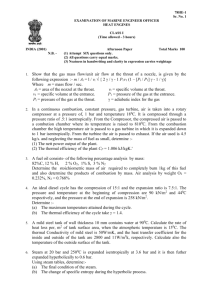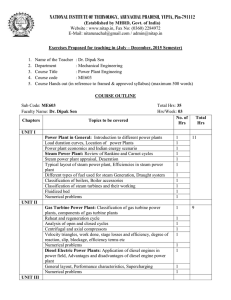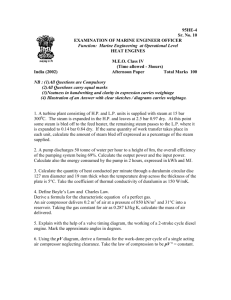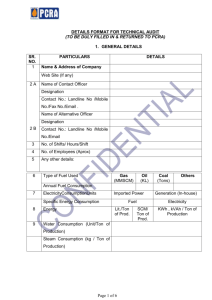Steam Power Plant
advertisement
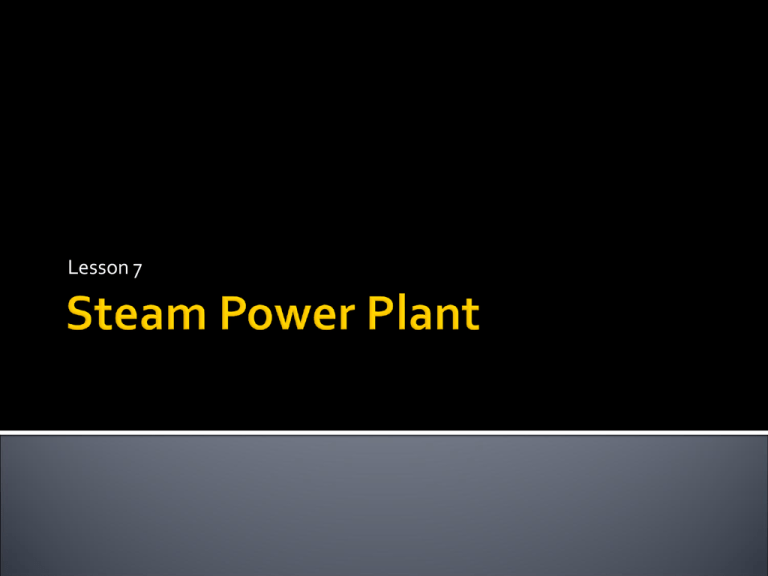
Lesson 7 mechanical power is produced by a heat engine that transforms thermal energy (from combustion of a fuel) into rotational energy heat (generated in the furnace) is transmitted to the boiler where water forced into the boiler by the feed pump is converted into steam steam drives turbine blades shaft the efficiency of a steam turbine is limited by the maximum temperature of the steam produced and is not directly a function of the fuel used (for the same steam conditions, coal, nuclear and gas power plants all have the same theoretical efficiency) Operating pressure Boiler efficiency Steaming hours Heating surface Generating surface Superheated steam Operating pressure – the pressure at which the boiler is operated in service Boiler efficiency -the ratio between the thermal energy actually absorbed by water and the thermal energy available in fuel (80 – 90 %) Steaming hours -the time during which the boiler generates steam Heating surface -the total surface of all parts exposed to combustion gases (tubes, superheater, economiser) Generating surface - a part of the surface in which water is heated and steam is generated (tubes, drum) Superheated steam = saturated steam + more heat at constant pressure –> dry steam (to avoid damage to tubine blades) FURNACE BOILER SUPERHEATER TURBINE CONDENSER a chamber in which heat is produced – combustion of fuel & generation of hot gases burners – break oil into fine particles to ensure efficient combustion steam generator – saturated & superheated steam steam drum - a reservoir of water/steam at the top end of the water tubes, it stores the steam generated in the water tubes and acts as a separator for the steam/water mixture (difference in densities) water circulation – natural or forced watertube boiler firetube boiler hot gases pass through the tubes, feed water surrounds them steam and water circulate through drums and small diameter tubes, gases of combustion pass around them more commonly used, lighter, occupies less space and has increased efficiency (higher pressure and temperature) main boiler donkey (auxiliary) boiler low, intermediate, high pressure b. single-drum b., two-drum b., three-drum b. vertical b., horizontal b. single-flow b., double-flow b. consists of headers and superheater tubes converts saturated steam into dry steam steam is admitted to the turbine heat energy is converted into mechanical energy – useful work high pressure turbine low pressure turbine heat exchanger tubes sea water steam water (condensate) vacuum is created due to steam / condensate volume difference vacuum is maintained by constant cool water circulation through the tubes CONDENSATE – COLLECTING TANK (HOTWELL) MAIN CONDENSATE PUMP AIR EJECTOR DEAERATING FEED TANK MAKE UP TANK (EMERGENCY FEED TANK) FEED PUMP FEED HEATER ECONOMISER condensate – collecting tank (hotwell) Main Condensate Pump to pump water from the hotwell through the main air ejector to the deaerating feed tank no moving parts jet pump Bernoulli’s principle to remove air and gases from the condensate to remove the oxygen from the system to heat the condensate to be used as storage tank for heated feed water Form: cylindrical tank in three sections First section (the lowest) – storage space = beginning of the feed phase Middle section: atomizing valve assembly to release entrapped air from the water Upper section: preheater compartment losses in cycle when the feed water level in the deaerating tank drops to a minimum, make-up feed water enters the system pump that forces feed water into the boiler preheats the feed water before it enters the boiler to improve the efficiency of the steam plant by using thermal energy, i.e. preheating the feedwater before it passes into the boiler water is heated under pressure to remove dissolved air and vapour to minimize internal boiler corrosion double-bottom tank -> transfer pump -> settling tank -> daily (service) tank -> fuel oil pressure pump -> strainer -> heater -> fine mesh -> burner (recirculating connection)


